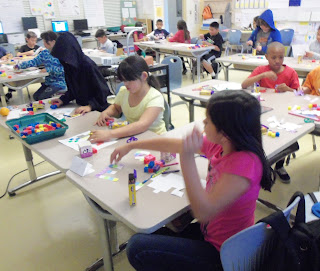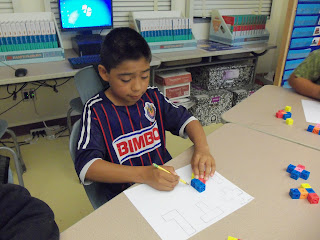 6.G.A.4 Represent three-dimensional figures using nets made up of rectangles and triangles, and use the nets to find the surface area of these figures. Apply these techniques in the context of solving real-world and mathematical problems.
6.G.A.4 Represent three-dimensional figures using nets made up of rectangles and triangles, and use the nets to find the surface area of these figures. Apply these techniques in the context of solving real-world and mathematical problems.
The children investigated to find all 12 pentomino shapes. A pentomino is a geometric shape formed by connecting five squares together edge to edge. We used snap cubes to construct ours.
There are exactly 12 unique shapes, not counting reflections and rotations. They spell "FLIP n TUVWXYZ." The "n" is what I also call the lightning bolt. Angie lists the shapes, but accidentally draws the "v" twice on her paper. Nicely drawn, Angie.

The girls are working together to find the 12 unique pentomino shapes.
If each side of a cube is a length of 1 unit, what is the perimeter of each pentomino?
 |
| Cutting on the edges of an open milk carton |
Next, I give each child a clean milk carton with the top cut off. The student carefully cuts along the edges of the carton to find a hidden pentomino.
Andy is holding the "F" pentomino he made.
Which shapes can you cut from a milk carton?
Kimberly found the "w."
Leslie cut out the "t."
Patricio found the "n" which is also called "the lightning bolt."
 |
 |
Jorge drew the pentomino shapes on 1-inch graph paper. Then he will make a t-chart and sort the pentomino shapes by those that make a box and those that do not.
Jason added the "y" to his collection.
 |
Deshawn proudly shows his sorted shapes of those that form an open box and those that do not.
This makes a delightful display on the wall for Open House, too.

Great fun! I enjoy helping the children see math in their everyday lives--and milk cartons are a perfect way to remind them that math is everywhere around them.























No comments:
Post a Comment